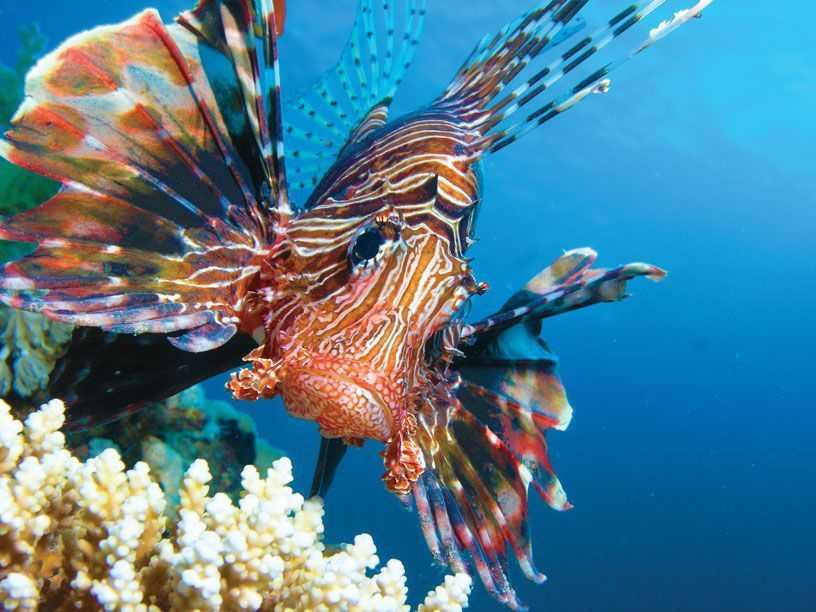Invasion Of The Red Lion
Lionfish Numbers Continue To Explode
Dr. Bob Shipp
Recently I judged the annual Flora-Bama fishing tournament at Perdido, Fla. New this year was a lionfish category, with spearing the preferred capture method. This was following a widely publicized “lionfish awareness week” in nine Florida Gulf coastal cities featuring “harvest” of lionfish by divers.
No lionfish arrived early on, but late in the second day our first entry was received. As it turned out, this was our only entry. But what an entry it was. A major league cooler was filled with lionfish, 88 of them. But this was a single entry, from a single dive, on a single reef. And they were all sizes, from about 4 inches to well over a foot.
The following week, on one of our reef fish research cruises out of Dauphin Island, Ala. we videoed five artificial reefs to do red snapper counts. The red snapper were there, to be sure, several hundred at each reef. But there were also swarms of lionfish at every reef. At one site there were so many lionfish that the reef structure could barely be seen.
The problem grows. It may well become one of the most vexing and serious fishery management problems of our decade. Let’s check off the various parameters which make this likely.
The red lionfish is an invasive species, native to the vast Indo Pacific Ocean. They escaped, probably from aquaria, sometime late in the twentieth century, around south Florida. Since then they have spread at a phenomenal rate up the Atlantic Coast, throughout the Caribbean, and now the Gulf of Mexico.
They reproduce at an incredible rate. Females can produce up to 30,000 eggs every four to six days. These are released in a gelatinous mass that affords the developing larvae additional protection during their short time in the plankton. They settle out in less than a month, and begin their predatory activities. They mature late during the first year, or shortly thereafter, and begin reproducing at about 5 to 6 inches.
They have no natural predators. While we have seen a few isolated videos of groupers engulfing lionfish, these are rare, and there’s no follow up on the likely misery of the predator resulting from punctures by the venomous lionfish spines. Sharks would be a likely candidate as a predator since they are known to ignore the defenses of venomous prey such as sting rays, but the lionfish stay so close to the reefs that they appear protected from attack by sharks. There are reports in the literature of cannibalism in lionfish, but we’ve seen no evidence of that to date.
The preferred food of lionfish are small live morsels, such as shrimp, crabs and, alas, juvenile fishes. They spread their huge gaudy fins to entrap their prey in a corner. They engulf them by the scores daily. So not only do they compete with our precious native species for food, they eat them as juveniles. About the only bright spot here is that many of our prize species, like red snapper or triggerfish, don’t recruit to the reefs until they are older. However, the same is not true for all; juvenile vermilion snapper swarm in droves around reefs, and are a prime target of lionfish.
The red lionfish have created their own niche in our coastal ecosystem. Since they appeared in the Gulf a little over a decade ago, they have become a dominant player in reef ecology. Only time will tell how their niche has shrunken or replaced that of our native species.
So what’s the solution to this challenging dilemma? Certainly removal from the reefs is the knee-jerk reaction. But when one lionfish is taken (it reminds me of the sorcerer’s apprentice) two more seem to take its place. A number of attempts to develop a lionfish trap have all failed, although I know there are ongoing efforts to continue this research.
Is there no silver lining to this terribly dark cloud? So far, the best hope seems to be to make the best of it. These fish are delicious. They make a dramatic culinary presentation. The venomous spines can be removed or the venom denatured rather easily (but carefully). And, as indicated above, they can be taken easily in large numbers by divers. The only problem with this potentially burgeoning commercial fishery is the lack of a steady supply. My son Matt owns Shipp’s Harbour Grill, a large seafood restaurant in Orange Beach, Ala. He has done wonders with the occasional lionfish provided to him. But he tells me he can’t put it on the menu until he’s confident of a reliable source.
That reliable source may be on the horizon. The divers I’ve talked to seem very interested in developing a consistent fishery for lionfish. But these guys are divers and spearfishermen, not trained in the profession of commercial fishing. My advice is to have them team up with one or more of the major commercial outlets along our coast and develop a sort of co-op of divers who together could provide the steady stream of lionfish product.
Wouldn’t this be a unique occurrence? Commercial and recreational fisherman addressing a problem jointly to the benefit of both sectors.
Bob Shipp can be reached at rshipp@southalabama.edu or via his website bobshipp.com.
